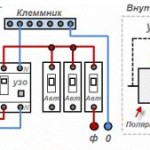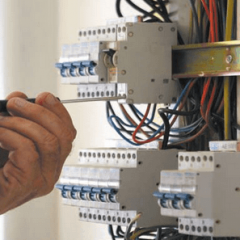How to connect an RCD?
RCD (see photo below) stands for residual current device. Its main purpose in electrics is to protect the wiring from current leakage. For example, due to your carelessness, you accidentally damaged the cable insulation and did not notice this. Any contact with exposed conductors may result in electric shock. To prevent this from happening, just this electrical product exists, which immediately turns off the electricity in the network when a current leak is detected.
We draw your attention to the fact that leakage can also occur due to aging of the mains. The old insulation simply bursts and bursts, resulting in a leakage current. That is why it is necessary to carry out on time home wiring replacement and be sure to connect the RCD with grounding!
The principle of operation is quite simple: the device compares the incoming current (phase) through itself with the outgoing (zero). Ideally, there should be no difference, if a slight difference is detected, the product immediately triggers. There are others reasons for the operation of the RCD which we talked about in the corresponding article!
Main disadvantages
Among the shortcomings of the residual current device, it is worth highlighting:
- If protection is set for all electrical wiring in the house, then at the slightest risk of leakage, the electricity in the entire private house may turn off at a time when you are not. False alarms sometimes cause a lot of problems, for example, if you leave for a few days and the lights go out, the refrigerator defrosts and street lights turn off.
- Connecting an RCD to the mains does not solve the problem of short circuit and overload of the wiring line. In the event of a short circuit, the device will simply fail. Therefore, together with the product it is absolutely necessary connect circuit breaker.
Wiring diagram
To your attention the simplest schemes for connecting a two-pole RCD to a single-phase network with your own hands. We draw attention to the fact that protection must be installed immediately after the meter so that monitoring is carried out for all wiring. It is also recommended to carry out wiring on each individual section of the circuit so that the current is switched off only for that section where leakage occurs (for example, only to a bathtub, to a washing machine or only to sockets).
So we figured out the purpose of the residual current device and its self-installation scheme. Now let's move on to the process of connecting to a 220 Volt network.
Installation Rules
Installing an RCD with your own hands is not difficult, even for a novice electrician. Consider step-by-step instructions for connecting in an apartment and a house.
Step 1 - Power Outage
First you need to turn off the electricity in the network and check its presence with a multimeter or indicator screwdriver.
Step 2 - Determining the Installation Location
It is up to you to connect the product immediately after the meter or on a separate section of the circuit. We recommend installation immediately after the electricity meter, but before the introductorycircuit breaker (to protect the device from short-circuit currents).
Step 3 - Connect
Everything is extremely simple here - it is necessary to bring and connect the wire strands in special holes (above and below). The connection diagram is displayed on the front panel of each model, as well as the necessary cores are indicated. For example, the 1-N, 2-N circuit means that phase and zero are wound up at the top, and phase and zero are also displayed at the bottom (polarity must be observed). If there is no phase and zero marking by color, they can be found with an indicator screwdriver (the lamp will not light up when you touch the core of zero).
Step 4 - Verification
After a full connection of the RCD, it is necessary to check its legal capacity. This can be done using the dedicated test button on the front panel. When it is pressed, the leakage current is simulated, as a result of which the residual current device must trip. If everything worked, the installation was completed correctly.
Installation Errors
As in any business, during electrical work dangerous errors can be made. To prevent this from happening to you, now we will tell you the most common errors in connecting RCDs with our own hands:
- The supply core starts at the bottom of the housing. You do not need to do this, because even on the product diagram, the supply wire is connected from above. If connected incorrectly, the unit may fail.
- After the RCD, a circuit breaker is not installed. As we have already said, the residual current circuit breaker does not work in case of a short circuit, which can immediately damage the product. That is why be sure to connect the machine in the right place.
- Local sections of the protection device are not installed on separate sections of the large power grid. As a result, a leak may occur, due to which the power will turn off throughout the room.
We also recommend that you watch a visual video instruction, which presents all the connection errors:
Video instructions
To your attention, a video instruction for connecting a two-pole RCD to the wiring in the house:
And this video tutorial shows how to connect a four-pole residual current device without zero:
That is all I wanted to tell you about this issue. We hope that now you know how to properly connect the RCD in a single-phase and three-phase network!
Useful reading:













Hello everyone! Someone tell me how to connect the ouzo to a two-phase network. It is a two-phase ... .. phase of 127 V, between phase 220 V. There is no zero.
But isn’t it right to put the machine after the RCD and consumers have it, and not before the RCD, as shown in the video ?! Indeed, with a short circuit, an RCD, not protected by an automatic machine, can fail.
Hello Sergey! Thank you for your attention! The fact is that we provided this video tutorial so that site visitors can see how the installation of RCDs and connection of wires occurs. Above, we also provided connection schemes, which show that the RCD is protected by an automatic machine. In this video, perhaps the master simply did not fully assemble the shield, for example, after the RCD, he will also put a circuit breaker.
Hello, how to properly connect the fire extinguisher in the tn-c-s system. At the beginning there is an introductory machine, then three phases go to the counter.Is the PEN on the release bus chopped into N and PE, does the zero go to the counter from the same bus or already with a separate N? If not difficult, then still schematically depict.
thank
Why many do not trust the RCD. Not because it does not work, but because it works when you do not need it, you get tired of running outside to the shield and turning it on. Power 380 V. SIP - Shield - Introductory machine - Counter - RCD - output machine, further into the house and on the intermediate shield. Consumers refrigerator, TV, kettle sometimes, lighting. A total of 3.5 kilowatts. Introductory machine for 32 A, RCD for 40 A, output for 32 A. The light is off, the refrigerator is modern, the kettle is not on. One TV works. Periodically shutdown occurs. Could this be due to the “pilot” for the TV? Can it cause a current leak ??? The working zero and protective grounding after the RCD, and even before it, are not combined in the shield.
Try disconnecting your pilot, connecting the TV in another way. So to speak, by the method of exception, check.
In the schemes that illustrate the material, the RCD stands up to group machines. In the "Installation Errors" part, you already write that RCDs cannot be installed on machines. Where to look?
consumer -> machine -> RCD
Good day. Tell me pliz, something I’m completely confused if at the entrance to the house there is AB 50A behind it ouzo 63A300mA, and then there are groups of ouzo 10A10mA with several AB 10A, 16A30mA with several AB 16A and 25A30mA with several AB25, so in groups an unlimited number of ABs or is it still necessary to put the protection of the RCD itself in front of the RCD of each group? Thanks in advance
Do you connect groups without group machines simply through an RCD? If yes, then put the machines on each group or replace them with the difattomats. In general, there can be an unlimited number of machines in a group, the bottom line is that the total current is always limited by the input machine
Good afternoon.
I can’t find information on how to turn off the current on the input line (on the meter) in order to connect new wiring to it (after assembling the shield and wiring through the house) and not get killed 🙂
Visually, the meter is old, the most common for a single-phase network, and “above” it does not show any toggle switches for shutdown ...
The standard scheme for connecting household electrical networks provides that the meter is constantly connected to the supply network. This is done to exclude connection to the supply network by the meter. Thus, you need to agree with the organization servicing your network in order to disconnect the supply network for connecting the home network.
Good day! Tell me how to properly connect the induction 2-phase stove through an RCD? on the plate L1 L2 N1 N2, divided into 2 RCDs + 2 machines (L1 + N1) and (L2 + N2). In this case, when you turn on the stove, any of the RCDs periodically works (